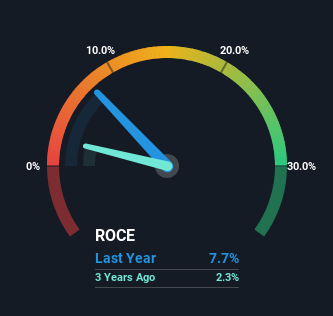- United States
- /
- Consumer Services
- /
- NYSE:EDU
New Oriental Education & Technology Group (NYSE:EDU) Will Want To Turn Around Its Return Trends

What trends should we look for it we want to identify stocks that can multiply in value over the long term? Ideally, a business will show two trends; firstly a growing return on capital employed (ROCE) and secondly, an increasing amount of capital employed. This shows us that it's a compounding machine, able to continually reinvest its earnings back into the business and generate higher returns. Although, when we looked at New Oriental Education & Technology Group (NYSE:EDU), it didn't seem to tick all of these boxes.
What Is Return On Capital Employed (ROCE)?
For those that aren't sure what ROCE is, it measures the amount of pre-tax profits a company can generate from the capital employed in its business. Analysts use this formula to calculate it for New Oriental Education & Technology Group:
Return on Capital Employed = Earnings Before Interest and Tax (EBIT) ÷ (Total Assets - Current Liabilities)
0.077 = US$350m ÷ (US$7.5b - US$3.0b) (Based on the trailing twelve months to May 2024).
Thus, New Oriental Education & Technology Group has an ROCE of 7.7%. On its own, that's a low figure but it's around the 7.4% average generated by the Consumer Services industry.
Check out our latest analysis for New Oriental Education & Technology Group

In the above chart we have measured New Oriental Education & Technology Group's prior ROCE against its prior performance, but the future is arguably more important. If you'd like to see what analysts are forecasting going forward, you should check out our free analyst report for New Oriental Education & Technology Group .
What Can We Tell From New Oriental Education & Technology Group's ROCE Trend?
In terms of New Oriental Education & Technology Group's historical ROCE movements, the trend isn't fantastic. Around five years ago the returns on capital were 12%, but since then they've fallen to 7.7%. Although, given both revenue and the amount of assets employed in the business have increased, it could suggest the company is investing in growth, and the extra capital has led to a short-term reduction in ROCE. And if the increased capital generates additional returns, the business, and thus shareholders, will benefit in the long run.
What We Can Learn From New Oriental Education & Technology Group's ROCE
Even though returns on capital have fallen in the short term, we find it promising that revenue and capital employed have both increased for New Oriental Education & Technology Group. However, despite the promising trends, the stock has fallen 44% over the last five years, so there might be an opportunity here for astute investors. So we think it'd be worthwhile to look further into this stock given the trends look encouraging.
If you're still interested in New Oriental Education & Technology Group it's worth checking out our FREE intrinsic value approximation for EDU to see if it's trading at an attractive price in other respects.
For those who like to invest in solid companies, check out this free list of companies with solid balance sheets and high returns on equity.
Valuation is complex, but we're here to simplify it.
Discover if New Oriental Education & Technology Group might be undervalued or overvalued with our detailed analysis, featuring fair value estimates, potential risks, dividends, insider trades, and its financial condition.
Access Free AnalysisHave feedback on this article? Concerned about the content? Get in touch with us directly. Alternatively, email editorial-team (at) simplywallst.com.
This article by Simply Wall St is general in nature. We provide commentary based on historical data and analyst forecasts only using an unbiased methodology and our articles are not intended to be financial advice. It does not constitute a recommendation to buy or sell any stock, and does not take account of your objectives, or your financial situation. We aim to bring you long-term focused analysis driven by fundamental data. Note that our analysis may not factor in the latest price-sensitive company announcements or qualitative material. Simply Wall St has no position in any stocks mentioned.
About NYSE:EDU
New Oriental Education & Technology Group
New Oriental Education & Technology Group Inc.
Flawless balance sheet and good value.
Similar Companies
Market Insights
Community Narratives



